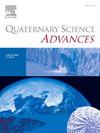Human Response to Cold Climate: First Evidence from the Tibetan Plateau during the Last Glacial Maximum
IF 2.2
Q2 GEOGRAPHY, PHYSICAL
引用次数: 0
Abstract
The Tibetan Plateau (TP) is a hotspot for early human history research, however, there is no evidence of prehistoric human activity on the southern TP during the Last Glacial Maximum (LGM). Thus, it remains unclear how the cold climate affected human activities and whether humans could survive such extremes on the Tibetan Plateau. Here, we present eight AMS 14C dates obtained from charcoal at a newly discovered blade site-Pengbuwuqing (PBWQ) in the Yarlung Zangbo River Valley basin, southern TP. We have also identified ochre at Paleolithic sites on the TP for the first time. Our chronological data indicate the human occupation of the Yarlung Tsangpo River basin during MIS2 (cal 29.2–27.0 kyr B.P), (cal 25.03–24.37 kyr B.P), and (cal 23.7–23.1 kyr B.P). This site represents the first evidence of human activity during the LGM in the southern TP valley and indicates that the southern TP river valley could have served as a refugium enabling prehistoric humans to survive the cold LGM on the TP.
人类对寒冷气候的反应:末次盛冰期青藏高原的第一个证据
青藏高原是早期人类历史研究的热点地区,但末次盛冰期青藏高原南部没有史前人类活动的证据。因此,目前尚不清楚寒冷气候如何影响人类活动,以及人类能否在青藏高原这样的极端环境中生存下来。本文对青藏高原南部雅鲁藏布江流域彭布武青(PBWQ)新发现的叶片遗址进行了8次AMS 14C测年。我们还首次在青藏高原的旧石器时代遗址中发现了赭石。我们的年代学资料表明,人类在MIS2 (cal 29.2 ~ 27.0 kyr b.p.)、(cal 25.03 ~ 24.37 kyr b.p.)和(cal 23.7 ~ 23.1 kyr b.p.)三个时期对雅鲁藏布江流域进行了活动。该遗址是青藏高原南部河谷LGM时期人类活动的第一个证据,表明青藏高原南部河谷可能是史前人类在青藏高原寒冷的LGM中生存下来的避难所。
本文章由计算机程序翻译,如有差异,请以英文原文为准。
求助全文
约1分钟内获得全文
求助全文
来源期刊

Quaternary Science Advances
Earth and Planetary Sciences-Earth-Surface Processes
CiteScore
4.00
自引率
13.30%
发文量
16
审稿时长
61 days
 求助内容:
求助内容: 应助结果提醒方式:
应助结果提醒方式:


